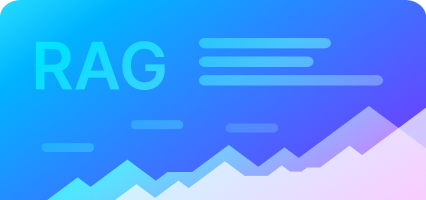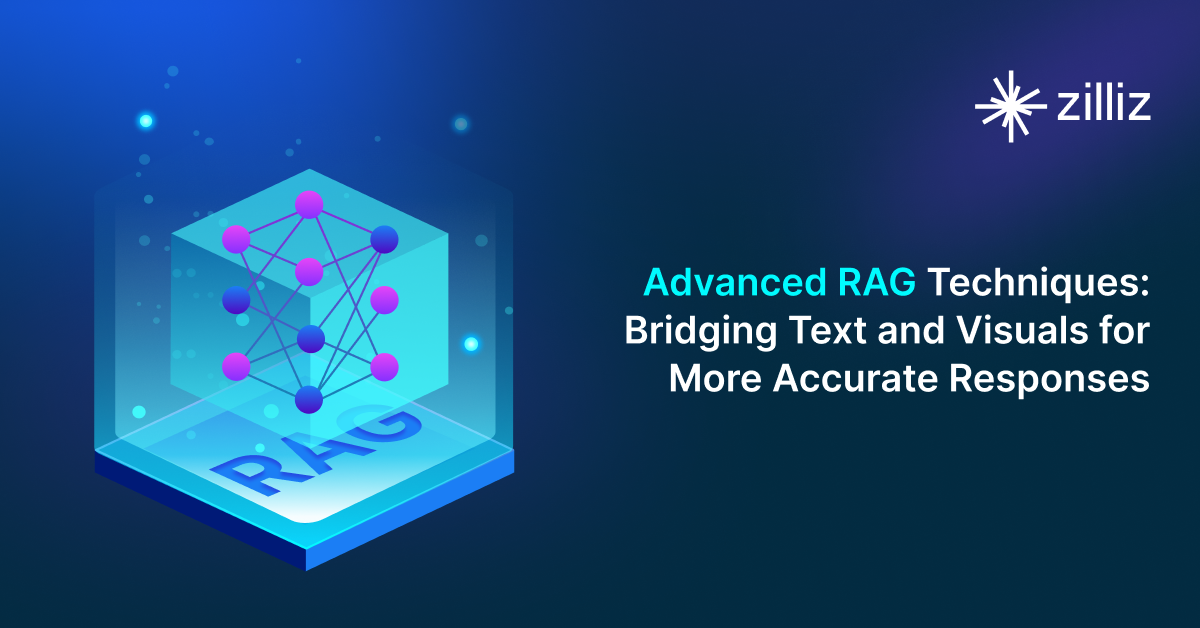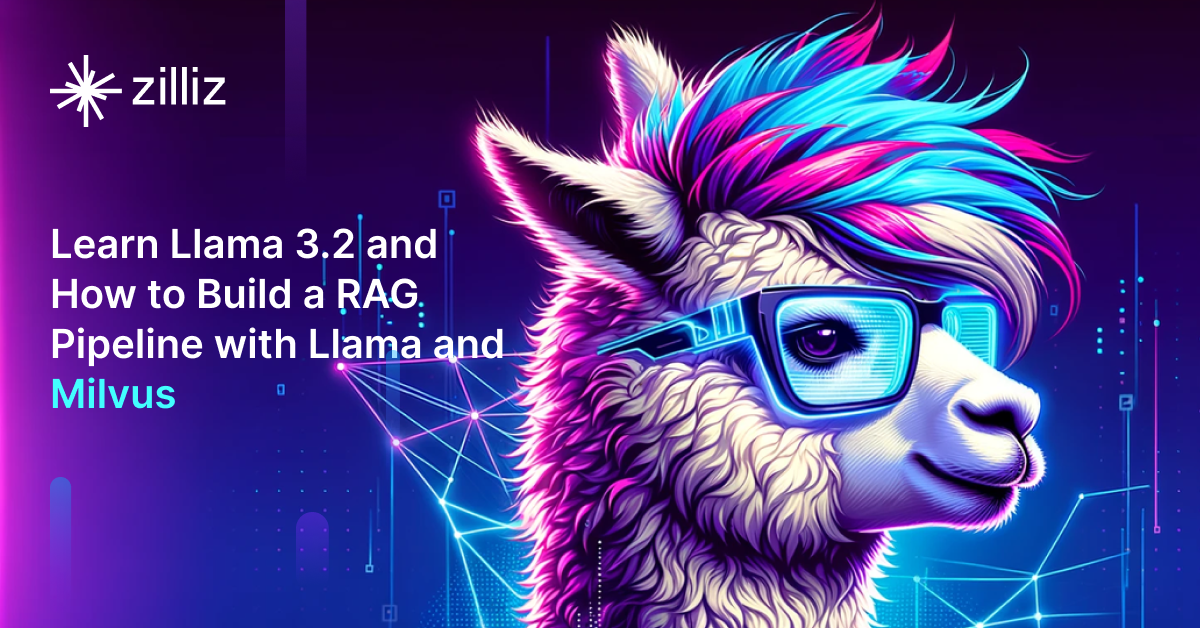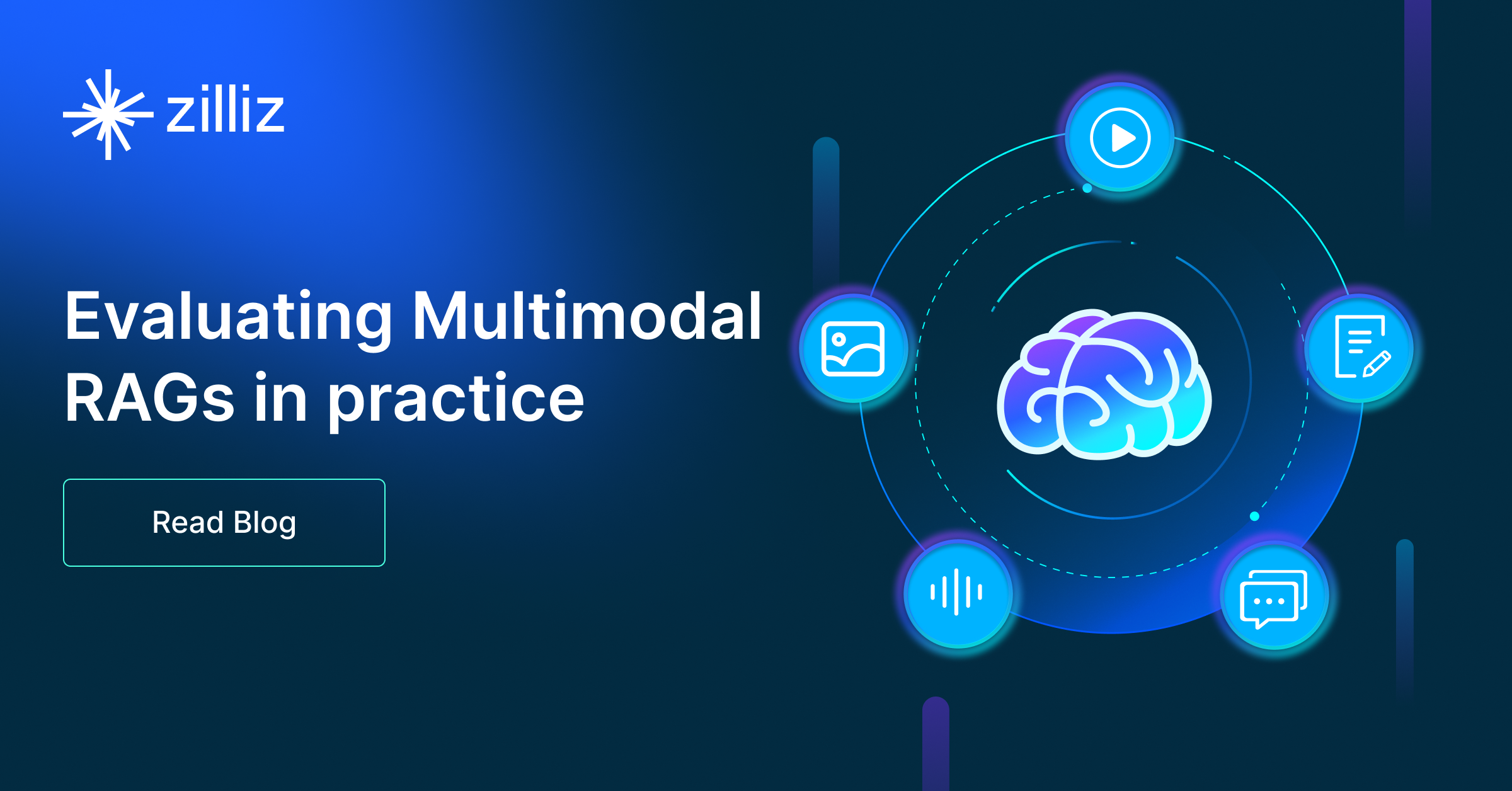Build RAG Chatbot with LangChain, Milvus, OpenAI GPT-o1, and HuggingFace all-MiniLM-L12-v1
Introduction to RAG
Retrieval-Augmented Generation (RAG) is a game-changer for GenAI applications, especially in conversational AI. It combines the power of pre-trained large language models (LLMs) like OpenAI’s GPT with external knowledge sources stored in vector databases such as Milvus and Zilliz Cloud, allowing for more accurate, contextually relevant, and up-to-date response generation. A RAG pipeline usually consists of four basic components: a vector database, an embedding model, an LLM, and a framework.
Key Components We'll Use for This RAG Chatbot
This tutorial shows you how to build a simple RAG chatbot in Python using the following components:
- LangChain: An open-source framework that helps you orchestrate the interaction between LLMs, vector stores, embedding models, etc, making it easier to integrate a RAG pipeline.
- Milvus: An open-source vector database optimized to store, index, and search large-scale vector embeddings efficiently, perfect for use cases like RAG, semantic search, and recommender systems. If you hate to manage your own infrastructure, we recommend using Zilliz Cloud, which is a fully managed vector database service built on Milvus and offers a free tier supporting up to 1 million vectors.
- OpenAI GPT-01: This foundational model marks the beginning of OpenAI’s generative pre-trained transformers. With its broad training on diverse text, GPT-01 is proficient in various NLP tasks including text generation, translation, and conversation. Its versatility makes it ideal for prototyping applications and enhancing interactive user experiences in early AI deployments.
- HuggingFace all-MiniLM-L12-v1: This model is a lightweight transformer designed for efficient natural language understanding and generation tasks. It excels in providing high-quality embeddings for various applications, including search, clustering, and conversational AI, while maintaining a small footprint for faster inference and deployment. Ideal for resource-constrained environments or mobile applications, it offers a balance between performance and efficiency.
By the end of this tutorial, you’ll have a functional chatbot capable of answering questions based on a custom knowledge base.
Note: Since we may use proprietary models in our tutorials, make sure you have the required API key beforehand.
Step 1: Install and Set Up LangChain
%pip install --quiet --upgrade langchain-text-splitters langchain-community langgraph
Step 2: Install and Set Up OpenAI GPT-o1
pip install -qU "langchain[openai]"
import getpass
import os
if not os.environ.get("OPENAI_API_KEY"):
os.environ["OPENAI_API_KEY"] = getpass.getpass("Enter API key for OpenAI: ")
from langchain.chat_models import init_chat_model
llm = init_chat_model("o1", model_provider="openai")
Step 3: Install and Set Up HuggingFace all-MiniLM-L12-v1
pip install -qU langchain-huggingface
from langchain_huggingface import HuggingFaceEmbeddings
embeddings = HuggingFaceEmbeddings(model_name="sentence-transformers/all-MiniLM-L12-v1")
Step 4: Install and Set Up Milvus
pip install -qU langchain-milvus
from langchain_milvus import Milvus
vector_store = Milvus(embedding_function=embeddings)
Step 5: Build a RAG Chatbot
Now that you’ve set up all components, let’s start to build a simple chatbot. We’ll use the Milvus introduction doc as a private knowledge base. You can replace it with your own dataset to customize your RAG chatbot.
import bs4
from langchain import hub
from langchain_community.document_loaders import WebBaseLoader
from langchain_core.documents import Document
from langchain_text_splitters import RecursiveCharacterTextSplitter
from langgraph.graph import START, StateGraph
from typing_extensions import List, TypedDict
# Load and chunk contents of the blog
loader = WebBaseLoader(
web_paths=("https://milvus.io/docs/overview.md",),
bs_kwargs=dict(
parse_only=bs4.SoupStrainer(
class_=("doc-style doc-post-content")
)
),
)
docs = loader.load()
text_splitter = RecursiveCharacterTextSplitter(chunk_size=1000, chunk_overlap=200)
all_splits = text_splitter.split_documents(docs)
# Index chunks
_ = vector_store.add_documents(documents=all_splits)
# Define prompt for question-answering
prompt = hub.pull("rlm/rag-prompt")
# Define state for application
class State(TypedDict):
question: str
context: List[Document]
answer: str
# Define application steps
def retrieve(state: State):
retrieved_docs = vector_store.similarity_search(state["question"])
return {"context": retrieved_docs}
def generate(state: State):
docs_content = "\n\n".join(doc.page_content for doc in state["context"])
messages = prompt.invoke({"question": state["question"], "context": docs_content})
response = llm.invoke(messages)
return {"answer": response.content}
# Compile application and test
graph_builder = StateGraph(State).add_sequence([retrieve, generate])
graph_builder.add_edge(START, "retrieve")
graph = graph_builder.compile()
Test the Chatbot
Yeah! You've built your own chatbot. Let's ask the chatbot a question.
response = graph.invoke({"question": "What data types does Milvus support?"})
print(response["answer"])
Example Output
Milvus supports various data types including sparse vectors, binary vectors, JSON, and arrays. Additionally, it handles common numerical and character types, making it versatile for different data modeling needs. This allows users to manage unstructured or multi-modal data efficiently.
Optimization Tips
As you build your RAG system, optimization is key to ensuring peak performance and efficiency. While setting up the components is an essential first step, fine-tuning each one will help you create a solution that works even better and scales seamlessly. In this section, we’ll share some practical tips for optimizing all these components, giving you the edge to build smarter, faster, and more responsive RAG applications.
LangChain optimization tips
To optimize LangChain, focus on minimizing redundant operations in your workflow by structuring your chains and agents efficiently. Use caching to avoid repeated computations, speeding up your system, and experiment with modular design to ensure that components like models or databases can be easily swapped out. This will provide both flexibility and efficiency, allowing you to quickly scale your system without unnecessary delays or complications.
Milvus optimization tips
Milvus serves as a highly efficient vector database, critical for retrieval tasks in a RAG system. To optimize its performance, ensure that indexes are properly built to balance speed and accuracy; consider utilizing HNSW (Hierarchical Navigable Small World) for efficient nearest neighbor search where response time is crucial. Partitioning data based on usage patterns can enhance query performance and reduce load times, enabling better scalability. Regularly monitor and adjust cache settings based on query frequency to avoid latency during data retrieval. Employ batch processing for vector insertions, which can minimize database lock contention and enhance overall throughput. Additionally, fine-tune the model parameters by experimenting with the dimensionality of the vectors; higher dimensions can improve retrieval accuracy but may increase search time, necessitating a balance tailored to your specific use case and hardware infrastructure.
OpenAI GPT-o1 optimization tips
GPT-o1 is designed for optimized efficiency and cost-effectiveness, making it well-suited for scalable RAG systems. Improve retrieval performance by implementing dynamic retrieval depth—fetching broader context for complex queries and narrower focus for straightforward ones. Use prompt compression techniques to remove unnecessary metadata while maintaining core information. Adjust temperature settings (0.1–0.3) based on the required response specificity, ensuring balanced output quality. Deploy caching strategies for repeated queries to enhance response speed and lower operational costs. Utilize function calling to structure responses and avoid ambiguous or overly verbose answers. When handling large-scale workloads, distribute requests across multiple instances to balance resource allocation and reduce bottlenecks. Monitor API usage and optimize retrieval strategies continuously to maintain efficiency.
HuggingFace all-MiniLM-L12-v1 optimization tips
To optimize the HuggingFace all-MiniLM-L12-v1 model for your Retrieval-Augmented Generation (RAG) setup, consider implementing mixed precision training to speed up computations and reduce memory usage, enabling you to handle larger batch sizes. Experiment with layer freezing during fine-tuning to preserve certain parameters while optimizing others, ensuring faster convergence. Use an efficient data preprocessing pipeline to reduce input bottlenecks, and implement caching mechanisms for frequently accessed data. Furthermore, leverage model distillation techniques to create smaller, faster versions of the model that maintain comparable performance, and experiment with different pooling strategies to find the most effective way to condense retrieved documents for better context input. Lastly, regularly monitor and fine-tune hyperparameters such as learning rate and batch size based on validation performance to achieve optimal results.
By implementing these tips across your components, you'll be able to enhance the performance and functionality of your RAG system, ensuring it’s optimized for both speed and accuracy. Keep testing, iterating, and refining your setup to stay ahead in the ever-evolving world of AI development.
RAG Cost Calculator: A Free Tool to Calculate Your Cost in Seconds
Estimating the cost of a Retrieval-Augmented Generation (RAG) pipeline involves analyzing expenses across vector storage, compute resources, and API usage. Key cost drivers include vector database queries, embedding generation, and LLM inference.
RAG Cost Calculator is a free tool that quickly estimates the cost of building a RAG pipeline, including chunking, embedding, vector storage/search, and LLM generation. It also helps you identify cost-saving opportunities and achieve up to 10x cost reduction on vector databases with the serverless option.
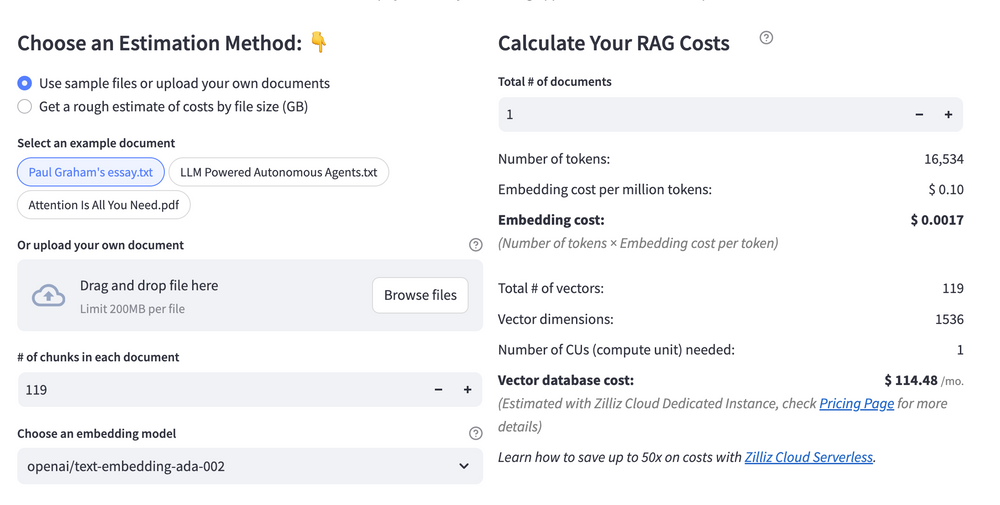 Calculate your RAG cost
Calculate your RAG cost
What Have You Learned?
By diving into this tutorial, you’ve unlocked the magic of building a RAG system from the ground up! You discovered how LangChain acts as the glue, seamlessly connecting your pipeline’s components and orchestrating workflows like document loading, chunking, and response generation. Then, Milvus stepped in as your powerhouse vector database, storing and retrieving embeddings at lightning speed to find the most relevant context for your queries. The HuggingFace all-MiniLM-L12-v1 model transformed text into rich numerical embeddings, capturing meaning in a way machines understand, while OpenAI’s GPT (or your chosen LLM) brought those insights to life with human-like answers. Together, these tools turned raw data into a dynamic, knowledge-driven chatbot or assistant—proof that cutting-edge AI isn’t just for big tech companies anymore!
But wait, there’s more! You also picked up pro tips for optimizing your RAG pipeline, like tweaking chunk sizes for better retrieval or fine-tuning your LLM’s prompts for sharper responses. And that free RAG cost calculator? A game-changer for balancing performance and budget as you scale. Imagine the possibilities now—personalized customer support bots, AI-powered research tools, or even creative writing assistants. You’ve got the blueprint and the tools. So what’s next? Start experimenting! Tweak parameters, swap models, or integrate new data sources. The world of generative AI is yours to explore, and every iteration brings you closer to something groundbreaking. Go build, optimize, and innovate—your next big idea is just a RAG pipeline away! 🚀
Further Resources
🌟 In addition to this RAG tutorial, unleash your full potential with these incredible resources to level up your RAG skills.
- How to Build a Multimodal RAG | Documentation
- How to Enhance the Performance of Your RAG Pipeline
- Graph RAG with Milvus | Documentation
- How to Evaluate RAG Applications - Zilliz Learn
- Generative AI Resource Hub | Zilliz
We'd Love to Hear What You Think!
We’d love to hear your thoughts! 🌟 Leave your questions or comments below or join our vibrant Milvus Discord community to share your experiences, ask questions, or connect with thousands of AI enthusiasts. Your journey matters to us!
If you like this tutorial, show your support by giving our Milvus GitHub repo a star ⭐—it means the world to us and inspires us to keep creating! 💖
- Introduction to RAG
- Key Components We'll Use for This RAG Chatbot
- Step 1: Install and Set Up LangChain
- Step 2: Install and Set Up OpenAI GPT-o1
- Step 3: Install and Set Up HuggingFace all-MiniLM-L12-v1
- Step 4: Install and Set Up Milvus
- Step 5: Build a RAG Chatbot
- Optimization Tips
- RAG Cost Calculator: A Free Tool to Calculate Your Cost in Seconds
- What Have You Learned?
- Further Resources
- We'd Love to Hear What You Think!
Content
Vector Database at Scale
Zilliz Cloud is a fully-managed vector database built for scale, perfect for your RAG apps.
Try Zilliz Cloud for Free